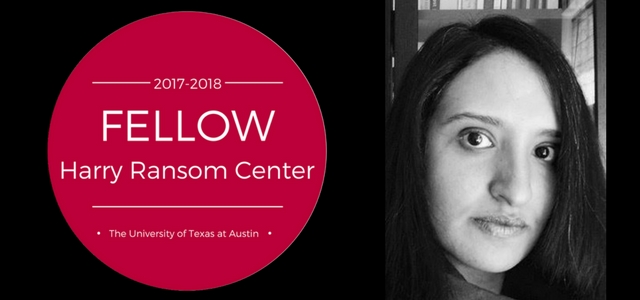
Ruksana Abdul-Majid, an independent scholar, discusses her research interests in advance of her visit to the Ransom Center.
Abdul-Majid is supported by the Andrew W. Mellon Foundation Research Fellowship Endowment.
Tell us about your research, “A Critical Edition of G. V. Desani’s The Indian Journal (1951–1958).”
My research project aims to produce a critical edition of pioneering early Anglophone Indian writer G. V. Desani’s unpublished travel memoir, The Indian Journal (1951–1958). Specifically, I will be completing the process of transcribing and translating the collective manuscript notebooks comprising Desani’s Journal, with a view to making available for the first time this rich and multi-layered, but largely untapped, documentary resource.
What initially drew you to your topic?
My interest in Desani speaks to my wider interest in Anglophone Indian writing across the twentieth century. Desani remains a key figure in genealogies of the development of the Anglophone Indian novel, yet despite the singularity and exemplarity of his literary work, his legacy has more often than not been characterised in terms of conspicuous gaps and elisions — to date, he has remained an understudied and enigmatic figure. In chronicling a chapter of Desani’s life that has often been described as an extended period of ‘silence,’ The Indian Journal is therefore an opportunity to bridge the lacuna in existing engagements with his life and work.
Which collections at the Ransom Center are most relevant to your research?
The G. V. Desani papers.
Are there specific questions you hope your research here will answer?
Aside from enriching the biographical account of Desani’s life, I’m hoping the Journal will offer some insight into his creative process. In addition, the notebooks are likely to provide a unique viewpoint on post-independence India and the transitional decade of the 1950s.
Why is it important that you visit the Ransom Center to work on-site with original materials?
The Ransom Center collection of the Desani papers holds the collective manuscript notebooks comprising The Indian Journal. This repository also houses the most comprehensive collection of his later journalistic work in the Indian press, which is relevant to my research project.
Outside your primary research interest, are there other collection items at the Ransom Center that you hope to see?
If I have the time, I’m keen to do a little exploring in the Ransom Center’s collections of materials pertaining to other Anglophone Indian writers, such as Mulk Raj Anand and R. K. Narayan, as well as the recently acquired Raja Rao papers.
